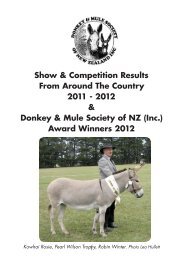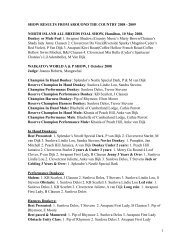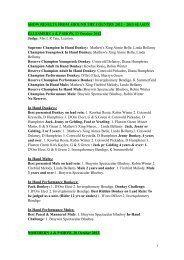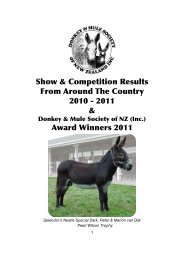reg notes - Donkey & Mule Society of New Zealand
reg notes - Donkey & Mule Society of New Zealand
reg notes - Donkey & Mule Society of New Zealand
Create successful ePaper yourself
Turn your PDF publications into a flip-book with our unique Google optimized e-Paper software.
Important Registry Notes<br />
www.donkey-mule.org.nz<br />
‘American Miniature<br />
Mediterranean <strong>Donkey</strong>’<br />
(AMMD)<br />
This is the <strong>of</strong>ficial name <strong>of</strong> your miniature donkey with American/Mediterranean bloodlines.<br />
The <strong>reg</strong>istry does not use the terms Sicilian and Sardinian because these donkeys are a mixture <strong>of</strong><br />
animals from Sicily, Sardinia, Ethiopia (at least one foundation jack was imported from ‘Abyssinia’<br />
- Ethiopia), and untraced stock in the United States. Since the foundation stock came from around<br />
the Mediterranean Sea and they have originally been imported from the USA we have used the term<br />
American Miniature Mediterranean <strong>Donkey</strong> as the <strong>of</strong>ficial breed name in <strong>New</strong> <strong>Zealand</strong>.<br />
To <strong>reg</strong>ister a donkey, the owner does not have to be a member <strong>of</strong> the <strong>Donkey</strong> & <strong>Mule</strong> <strong>Society</strong><br />
<strong>of</strong> <strong>New</strong> <strong>Zealand</strong> (Inc.), however, different <strong>reg</strong>istration fees will apply.<br />
PLEASE NOTE:<br />
The Registry Sub Committee reserves the right to refuse any application for entry to the<br />
Registers and the right to amend the Rules as and when it considers necessary.<br />
Prefix Rules:<br />
Breeders must <strong>reg</strong>ister their stud name (Prefix) with the <strong>Donkey</strong> & <strong>Mule</strong> <strong>Society</strong> <strong>of</strong> NZ. That<br />
prefix may only be used for donkeys that are bred by the owner <strong>of</strong> that prefix. The Breeder <strong>of</strong><br />
a donkey is the <strong>reg</strong>istered owner, or lessee, <strong>of</strong> the jenny at the time <strong>of</strong> foaling. You may use the<br />
Breeder’s Prefix if you have an agreement with them on that ONE animal. (Breeders - if you want<br />
the animal to reflect your stud name, you should be the first person to <strong>reg</strong>ister the animal).<br />
Suffix:<br />
Not applicable. (No donkey will be accepted for entry in the Registers with a name, which includes<br />
a Prefix and a Suffix, unless it already has both on foreign <strong>reg</strong>istration certificates).<br />
Name:<br />
The first person to <strong>reg</strong>ister the animal must choose the animal’s name. Once <strong>reg</strong>istered, name<br />
changes are not possible. The name must not be longer than 45 letters (including prefix and spaces).<br />
Updates:<br />
All numbers assigned are permanent – we do not issue “temporary” numbers. A ‘Temporary<br />
Certificate’ is given to animals under 3 and have no adult heights listed on them. The mature<br />
height, colour (in summer coat), markings hidden by foal fuzz, electronic implants, brands, tattoos,<br />
scars, etc, should be sent in after the age <strong>of</strong> 3 for a Mature Update.<br />
The Original Certificate must be returned with the additional information, including 2 NEW<br />
PHOTOS preferably in summer coat.<br />
1
All Changes to Certificates:<br />
Transfers, updates, corrections, must be accompanied by the original certificate (NOT a<br />
photocopy - keep the photocopy for yourself but return the actual certificate to the Registrar),<br />
with photos attached. Do not mark on the certificate unless corrections must be made. Temporary<br />
Certificates have transfer information added on and are returned to the owner. DO NOT FOLD<br />
CERTIFICATES. Do not remove photos from certificates.<br />
All Registration Applications and Mature Updates Must Have<br />
Clear Photos:<br />
Photos are required with ALL applications <strong>reg</strong>ardless <strong>of</strong> animal’s age. The <strong>reg</strong>istry requires two<br />
photos (one <strong>of</strong> each side) <strong>of</strong> a full side view <strong>of</strong> the animal, which show the appearance, colour and<br />
markings <strong>of</strong> the animal clearly to help in identification. Colour must be true in photos-especially on<br />
unusual colours such as sorrel/black. All colours are determined by the freshly shed SUMMER<br />
COAT. Winter coats, clipped coats and foal coats will be deceptive as to colour. The colours shown<br />
on the <strong>reg</strong>istration certificate will simply say grey dun, brown, black, white, broken coloured, red<br />
and roan (with attached colour designation), with light or dark to designate shades. Colours shown<br />
in photos MUST match the colour provided for the <strong>reg</strong>istration certificate. The Miniature <strong>Donkey</strong><br />
Registrar reserves the right to change the name <strong>of</strong> the colour if the description does not match the<br />
photo. We must be able to identify the animal in the photo. Photos that are too dark, the animal is<br />
too far away, is in a group, or the shoulder stripe (if the animal has one) cannot be clearly seen are<br />
<strong>of</strong> no use. If additional photos are required, your <strong>reg</strong>istration may be delayed. PHOTOS CAN BE<br />
DECEIVING - please take photos level with the animals and NOT FROM ABOVE, with a<br />
plain background. If poor conformation is shown in photos, you may be asked to re-shoot photos<br />
and again your <strong>reg</strong>istration may be delayed. Good quality photos can be sent by email to the<br />
<strong>reg</strong>istrar’s address.<br />
Mature Height:<br />
Please make sure mature heights are included on any paperwork for animals over the age <strong>of</strong> three. If<br />
this is missing, it will result in either a delay, or non-issue <strong>of</strong> the permanent <strong>reg</strong>istration certificate.<br />
For <strong>reg</strong>istration purposes, only selected trained measurers, holding an approved measuring<br />
stick, and appointed by the DONKEY & MULE SOCIETY <strong>of</strong> NZ for your area can perform<br />
MEASUREMENTS OF MINIATURE DONKEYS. (Please contact the MD Registrar for the<br />
names <strong>of</strong> the approved measurer in your area). Where the SOCIETY is satisfied that compliance <strong>of</strong><br />
the above mentioned rule would be unreasonably difficult, it may, without prejudice, accept other<br />
reliable documentation as evidence <strong>of</strong> height and instruct the MD Registrar to issue the appropriate<br />
certificate.<br />
Measurement Procedure:<br />
All donkeys shall be measured according to the Rules <strong>of</strong> the <strong>Society</strong>. Only <strong>of</strong>ficial measurers,<br />
appointed by the <strong>Society</strong> can measure donkeys and mules. Measurements must be taken with an<br />
approved, properly calibrated measuring stick fitted with a side arm and leveling device. The<br />
measurement <strong>of</strong> animals must take place in a place open to all members. Any member can attend<br />
the measuring procedure should they wish to do so. (Please contact the MD Registrar for info on the<br />
next measuring day should you wish to attend).<br />
2
The correct procedure for height verification is to measure the animal from the withers to the<br />
ground with the front two legs vertical and in line with or parallel to the measuring device,<br />
and the back <strong>of</strong> the hocks in a vertical line to the donkey’s buttocks. The donkey’s head and<br />
neck should be in a natural position and the animal must stand squarely on all four feet on a<br />
level (concrete) surface. Have an assistant hold the animal, and measure the withers to ground<br />
three times to get a correct reading. Measurement should be given in increments no smaller than ¼<br />
inches.<br />
A Witness shall assist and scrutinise the Measurer and also examine the measuring stick reading.<br />
Witness and Measurer must also check all details on the Height Certificate including the animal’s<br />
correct Registration papers.<br />
Breeding Certificate:<br />
ANY DONKEY BEING REGISTERED must have a certificate <strong>of</strong> service (breeding certificate) with its<br />
<strong>reg</strong>istration application. In the case <strong>of</strong> new imports, the original (Overseas) Miniature<br />
Mediterranean <strong>Donkey</strong> Registration Certificates must be submitted to the MD Registrar for<br />
verification <strong>of</strong> pure American / European MMD bloodlines.<br />
Transfer <strong>of</strong> Registered Animal Into Someone Else’s Name:<br />
Transfer applications are available from the <strong>reg</strong>istry <strong>of</strong>fice. Please list Name and address <strong>of</strong> Seller,<br />
Name and address <strong>of</strong> Buyer, Date <strong>of</strong> sale, Name and <strong>reg</strong>istration # <strong>of</strong> animal, Mature height if<br />
animal was <strong>reg</strong>istered Before 3 years <strong>of</strong> age and is now past its third birthday (if no height is<br />
listed the animal will be transferred as immature and should still be updated at a later date<br />
with the appropriate fee.) If animal has changed from the photos please send new photos. Person<br />
doing the transfer must sign.<br />
Please return all <strong>of</strong> the above with the ORIGINAL CERTIFICATE. (if the original has been lost<br />
or destroyed, we need a note to that extent.)<br />
Oversized Miniature <strong>Donkey</strong>s:<br />
We will <strong>reg</strong>ister American Miniature Mediterranean <strong>Donkey</strong>s as oversized, up to 38” for breeding<br />
purposes only. This will only be done if the animal has a miniature pedigree (meaning Both parents<br />
must be 36” or under). All oversized donkeys will have an ‘O’ in front <strong>of</strong> their <strong>reg</strong>istration number<br />
and the amount they are oversized will appear under “description” on the papers. If the animal does<br />
not have a miniature pedigree <strong>of</strong> <strong>reg</strong>istered parents ( that is both parents <strong>reg</strong>istered 36” or under) it<br />
will not be <strong>reg</strong>istered as Miniature if it is oversized. It will be <strong>reg</strong>istered as small standard.<br />
Re-issue <strong>of</strong> Certificate:<br />
A certificate may be re-issued upon request due to damage or other problems, or changes in the<br />
animal such as colour changes etc. RE-ISSUE OF CERTIFICATE BECAUSE OF A MISTAKE. If<br />
the mistake was made by the <strong>reg</strong>istry the re-issued certificate is free. If the mistake was made on the<br />
<strong>reg</strong>istration application the cost will paid by the applicant.<br />
3
Lost Certificate:<br />
We must have written request, stating that the certificate was lost or destroyed for our records by the<br />
current owner before we can replace these certificates. Written re-issue orders are kept on file with<br />
the original application.<br />
Permanent Identification:<br />
Branding and /or Electronic identification is required for permanent <strong>reg</strong>istration. The brands must<br />
first be <strong>reg</strong>istered with the <strong>reg</strong>istrar. In view <strong>of</strong> World Wide standardization <strong>of</strong> Microchips in<br />
Miniature donkeys, it is recommended that the location <strong>of</strong> microchips be placed at the base <strong>of</strong> the<br />
left ear to provide consistency among Miniature <strong>Donkey</strong> owners. If micro chipped, a copy <strong>of</strong> the<br />
certificate must be supplied to the <strong>reg</strong>istrar.<br />
Where a donkey owner does not own a <strong>reg</strong>istered brand, the <strong>Donkey</strong> and <strong>Mule</strong> <strong>Society</strong> <strong>of</strong> NZ has a<br />
brand available for use in the North and South Island <strong>of</strong> NZ.<br />
<strong>Donkey</strong> and Colour Descriptions:<br />
PLEASE NOTE: All colours are determined by the freshly shed SUMMER COAT. Winter coats,<br />
clipped coats, and foal coats will be deceptive as to colour.<br />
The terms LIGHT or DARK can be added to all colours.<br />
N.L.P. stands for NO LIGHT POINTS.<br />
Grey-Dun:<br />
The most common <strong>of</strong> donkey colours. It is the original ‘wild’ colour. Body colour is some<br />
shade <strong>of</strong> grey or tannish grey ranging from very light oatmeal or light silver colour, to a very<br />
dark charcoal colour. Cross dorsal stripe, ear marks and <strong>of</strong>ten leg stripes (garters) or black dots<br />
on the lower part <strong>of</strong> the neck below the jowls are found. Grey-dun donkeys may have black<br />
muzzles and no light points (belly and legs as well as muzzle are usually lighter than the coat<br />
in all donkeys) and still be the grey dun colour.<br />
Brown:<br />
(Light, Dark, Very Dark)<br />
Black:<br />
(with cross, no visible cross). Black is sometimes a difficult colour to determine. There are<br />
two kinds <strong>of</strong> black, a raven black, which is easy to determine and a duller black, which could<br />
<strong>of</strong>ten be a very dark brown. If the donkey is ‘jet’ black or “raven” black with no visible cross<br />
and stripe it can be listed as black. If the coat appears black but the cross, stripe and lower legs<br />
are visibly darker black it is called Black with a cross (smoky black). Dark brown describes<br />
donkeys whose coats are very dark brown in appearance with darker cross, stripe and lower<br />
legs. This applies especially for foals. Charcoal is not a shade <strong>of</strong> black but the very darkest<br />
shade <strong>of</strong> grey-dun.<br />
White:<br />
(Frosted spotted white, or Ivory/Blue eyed White). Due to many factors White is not always<br />
snow white. Often it is yellowish. If a donkey has blue eyes and pink skin it is <strong>reg</strong>istered as<br />
White* (BEW) Blue-eyed white. Although there is no true pink-eyed albino in equines, the<br />
4
term albino - white is accepted in equine circles. The descriptive term is Ivory. Dark-eyed<br />
white donkeys with mottled skin are spotted and not true white.<br />
Broken Coloured:<br />
This is always listed as whatever the base colour is first, then ‘and white broken coloured’, e.g.<br />
‘Grey and white broken coloured’ or ‘brown and white broken coloured’. The eyes are dark.<br />
The skin (especially around the eyes, muzzle, and genitals) is broken coloured pink and black.<br />
The body may actually show mottled (patched) grey and pink skin, but the colour does not appear<br />
on the coat. A dark or partial cross, coloured ear tips, tail-tip, striped hooves, dark spots<br />
may be present in the foal coat, which fades out in the adult coat, leaving the broken coloured<br />
skin as the only indicator <strong>of</strong> the broken coloured pattern.<br />
Red:<br />
For all the red shades that are not bay, red roan or reddish brown. The description should be<br />
‘sorrel’. The majority <strong>of</strong> red donkeys have extensive white points as adults. If they are clearly<br />
frosty or dappled red roan it should be noted on their papers.<br />
Roan:<br />
Chocolate roan: Dark chocolate and white or fawn hairs mingling, dark predominating on the<br />
body. Light on face and legs. Mane and tail unusually dark. Blue roan: As above, but grey<br />
hairs replacing dark chocolate. Pink roan: As above, but fawn or chestnut hairs replacing the<br />
dark. Roans do not usually have a cross.<br />
D&MSNZ form 9/1/07<br />
5








